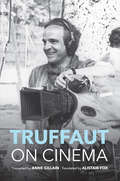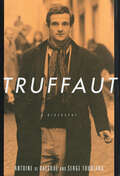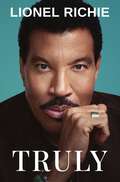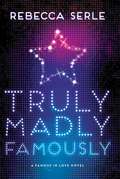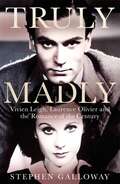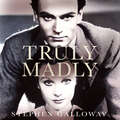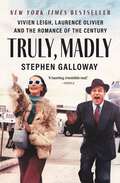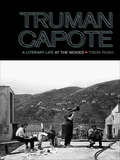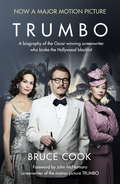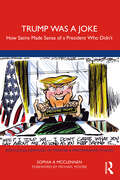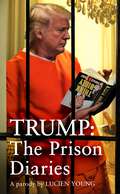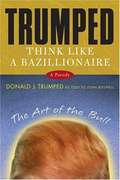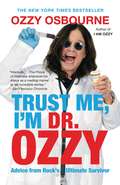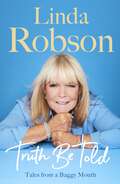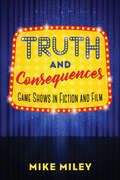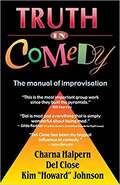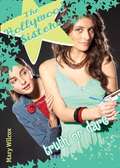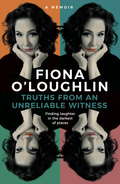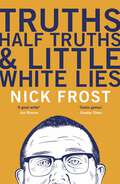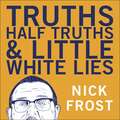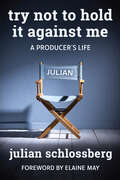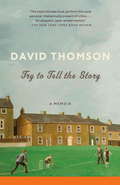- Table View
- List View
Truffaut on Cinema
by Anne Gillain“The writings reveal a Truffaut who was as incisive and direct in assessing his own work as he was in assessing the work of other directors.” —ChoiceBetween 1959 and 1984, French film director François Truffaut was interviewed over three hundred times. Each interview offers critical insight into the genesis of Truffaut’s films as he shares the sources of his inspiration, the choice of his themes, and the development of his screenplays. In addition, Truffaut discusses his relationships with collaborators, actors, and the circumstances surrounding the shooting of each film.These texts, originally assembled by Anne Gillain and published in French in 1988, are presented here in a montage arranged chronologically by film. This compilation includes an impressive array of reflections on cinema as an art form. Truffaut defines the aims and practices of the French New Wave, comparing their efforts to the films made by their predecessors and including comments that encompass the entire history of cinema. Truffaut on Cinema provides commentary on contemporary events, a wealth of biographical information, and Truffaut’s own artistic itinerary.
Truffaut: A Biography
by Antoine De Baecque Serge ToubianaOne of the most celebrated filmmakers of all time, Francois Truffaut was an intensely private individual who cultivated the public image of a man completely consumed by his craft. But his personal story—from which he drew extensively to create the characters and plots of his films—is itself an extraordinary human drama. Now, with captivating immediacy, Antoine de Baecque and Serge Toubiana give us the definitive story of this beloved artist. They begin with the unwanted, mischievous child who learned to love movies and books as an escape from sadness and confusion: as a boy, Francois came to identify with screen characters and to worship actresses. Following his early adult years as a journalist, during which he gained fame as France's most iconoclastic film critic, the obsessive prodigy began to make films of his own, and before he was thirty, notched the two masterpieces The 400 Blows and Jules and Jim. As Truffaut's dazzling body of work evolves, in the shadow of the politics of his day, including the student uprisings of 1968, we watch him learning the lessons of his masters Fellini and Hitchcock. And we witness the progress of his often tempestuous personal relationships, including his violent falling-out with Jean-Luc Godard (who owed Truffaut the idea for Breathless) and his rapturous love affairs with the many glamorous actresses he directed, among them Jacqueline Bisset and Jeanne Moreau. With Fanny Ardant, Truffaut had a child only thirteen months before dying of a brain tumor at the age of fifty-two.Here is a life of astonishing emotional range, from the anguish of severe depression to the exaltation of Oscar victory. Based on unprecedented access to Truffaut's papers, including notes toward an unwritten autobiography, de Baecque and Toubiana's richly detailed work is an incomparably authoritative revelation of a singular genius.
Truly
by Lionel Richie“Richie is refreshingly open in the book, which functions as both a fun memoir and a love letter to music and his beloved Tuskegee… There’s an abundance of love and gratitude in this wildly entertaining, utterly charming memoir.” – Kirkus, STARRED review. <P><P> The long-awaited memoir of the legendary Lionel Richie. As a storyteller second to none, Lionel Richie is ready to tell it all. In this intimate, deeply candid memoir, Lionel revisits hilarious and harrowing events to inspire all who doubt themselves or feel their dreams don’t matter. Lionel chronicles lessons learned during his unlikely story of remarkable success—his dramatic transformation from painfully shy, “tragically” late bloomer to world-class entertainer and composer of love songs that have played as the soundtrack of our lives. <P><P> Funny, warm, and riveting, Lionel recalls his childhood in Tuskegee, Alabama, where he grew up on its university campus during the heyday of the Civil Rights movement, raucous adventures as a member of The Commodores, coming-of-age in late 1960s Harlem, culture shock playing gigs on the French Riviera, the big break of being signed to Motown, his meteoric solo career that included an Olympics performance witnessed by two billion around the globe, all the way through to writing and recording “We Are the World” and his current multi-generational fame as a judge on American Idol. Even with its turbulence, loss, and near-calamity, Lionel’s journey takes us on a thrill ride and delivers a memoir for the ages—reminding us of the power of love to elevate our own lives and our world. <P><P> Lionel Richie’s memoir includes three eight-page photo inserts. <P><P> <B>New York Times Bestseller</B>
Truly Madly Famously (Famous in Love #2)
by Rebecca SerleSoon to be a series on Freeform, formerly ABC Family, starring Bella Thorne. "A must-read for anyone curious about life and love behind the scenes."--Bella Thorne, actor and author of Autumn Falls, on Famous in LoveLights, camera, love!After being plucked from obscurity, Hollywood's newest It Girl, Paige Townsen, has a blockbuster film to her name and Rainer Devon on her arm. But being half of the world's most famous couple comes with a price. No matter where Paige goes, someone is always watching. Soon she finds herself dodging photographers; hiding her feelings for her other costar, Jordan Wilder; and weathering tabloid scandals that threaten to tear her and Rainer apart--and end her career as quickly as it began.As she navigates her new L.A. life in this exciting sequel to Famous in Love, Paige finds that she doesn't know who to trust: Old friends could be betraying her secrets, and new friends are keeping secrets of their own.
Truly Madly: Vivien Leigh, Laurence Olivier and the Romance of the Century
by Stephen GallowayA sweeping and heartbreaking Hollywood biography about the passionate, turbulent marriage of Laurence Olivier and Vivien Leigh.As seen in the Daily Mail and Mail on SundayIn 1934, a friend brought fledgling actress Vivien Leigh to see Theatre Royal, where she would first lay eyes on Laurence Olivier in his brilliant performance as Anthony Cavendish. That night, she confided to a friend, he was the man she was going to marry. There was just one problem: she was already married-and so was he.TRULY, MADLY is the biography of a marriage, a love affair that still captivates millions, even decades after both actors' deaths. Vivien and Larry were two of the first truly global celebrities - their fame fueled by the explosive growth of tabloids and television, which helped and hurt them in equal measure. They seemed to have it all and yet, in their own minds, they were doomed, blighted by her long-undiagnosed mental-illness, which transformed their relationship from the stuff of dreams into a living nightmare.Through new research, including exclusive access to previously unpublished correspondence and interviews with their friends and family, author Stephen Galloway takes readers on a bewitching journey. He brilliantly studies their tempestuous liaison, one that took place against the backdrop of two world wars, the Golden Age of Hollywood and the upheavals of the 1960s - as they struggled with love, loss and the ultimate agony of their parting.
Truly Madly: Vivien Leigh, Laurence Olivier and the Romance of the Century
by Stephen GallowayA sweeping and heartbreaking Hollywood biography about the passionate, turbulent marriage of Laurence Olivier and Vivien Leigh.A New York Times bestsellerAs seen in the Daily Mail and Mail on SundayIn 1934, a friend brought fledgling actress Vivien Leigh to see Theatre Royal, where she would first lay eyes on Laurence Olivier in his brilliant performance as Anthony Cavendish. That night, she confided to a friend, he was the man she was going to marry. There was just one problem: she was already married-and so was he.TRULY, MADLY is the biography of a marriage, a love affair that still captivates millions, even decades after both actors' deaths. Vivien and Larry were two of the first truly global celebrities - their fame fueled by the explosive growth of tabloids and television, which helped and hurt them in equal measure. They seemed to have it all and yet, in their own minds, they were doomed, blighted by her long-undiagnosed mental-illness, which transformed their relationship from the stuff of dreams into a living nightmare.Through new research, including exclusive access to previously unpublished correspondence and interviews with their friends and family, author Stephen Galloway takes readers on a bewitching journey. He brilliantly studies their tempestuous liaison, one that took place against the backdrop of two world wars, the Golden Age of Hollywood and the upheavals of the 1960s - as they struggled with love, loss and the ultimate agony of their parting.
Truly, Madly: Vivien Leigh, Laurence Olivier, and the Romance of the Century
by Stephen GallowayNAMED A BEST BOOK OF THE YEAR BY THE WASHINGTON POST A New York Times Bestseller "A "well rounded and entertaining" (New York Times) Hollywood biography about the passionate, turbulent marriage of Laurence Olivier and Vivien Leigh. In 1934, a friend brought fledgling actress Vivien Leigh to see Theatre Royal, where she would first lay eyes on Laurence Olivier in his brilliant performance as Anthony Cavendish. That night, she confided to a friend, he was the man she was going to marry. There was just one problem: she was already married—and so was he. TRULY, MADLY is the biography of a marriage, a love affair that still captivates millions, even decades after both actors' deaths. Vivien and Larry were two of the first truly global celebrities – their fame fueled by the explosive growth of tabloids and television, which helped and hurt them in equal measure. They seemed to have it all and yet, in their own minds, they were doomed, blighted by her long-undiagnosed mental-illness, which transformed their relationship from the stuff of dreams into a living nightmare. Through new research, including exclusive access to previously unpublished correspondence and interviews with their friends and family, author Stephen Galloway takes readers on a bewitching journey. He brilliantly studies their tempestuous liaison, one that took place against the backdrop of two world wars, the Golden Age of Hollywood and the upheavals of the 1960s — as they struggled with love, loss and the ultimate agony of their parting.
Truman Capote: A Literary Life at the Movies (The South on Screen)
by Tison PughThe author of Queer Chivalry presents a biographical study of the celebrity writer &“rich with insight into [his] literary and cinematic achievements&” (Publishers Weekly). Truman Capote&’s legacy is in many ways defined by his complex relationship with Hollywood. In Truman Capote: A Literary Life at the Movies, Tison Pugh explores the author and his literature through a cinematic lens, weaving elements of Capote&’s biography—including his flamboyant public persona and his friendships and feuds with notable stars—with critical analysis of the films, screenplays, and adaptations of his works. Capote&’s masterful prose made him an iconic twentieth century author, and his screenplays, including Beat the Devil, Indiscretion of an American Wife, and The Innocents, allowed him to collaborate with such Hollywood heavyweights as Humphrey Bogart, John Huston, and David O. Selznick. But the beloved and acclaimed adaptations of his literature, most notably Breakfast at Tiffany&’s and In Cold Blood, undercut his daring treatment of homosexuality in favor of heterosexual romance. Pugh demonstrates how Capote&’s gay southern identity influenced perceptions of his literature and its adaptations. Illuminating Capote&’s successes and disappointments in the film industry, Pugh delivers a revealing and nuanced portrait of the author&’s literary life.
Trumbo: A biography of the Oscar-winning screenwriter who broke the Hollywood blacklist - Now a major motion picture
by Bruce CookNOMINATED FOR OSCAR, BAFTA AND GOLDEN GLOBE AWARDS (BRYAN CRANSTON, BEST ACTOR)Dalton Trumbo was the central figure of the infamous 'Hollywood Ten,' the screenwriters who, during the McCarthy era, were charged by the House Committee on Un-American Acitivities for their associations with the Communist Party. Due to their refusal to cooperate during the investigation, Trumbo and his fellow screenwriters were declared in contempt of Congress and were ultimately blacklisted from Hollywood and some were even jailed. Although Trumbo was one of several hundred writers, directors, producers, and actors who were deprived of the opportunity to work in the motion picture industry from 1947 to 1960, he won an Oscar under the pseudonym Robert Rich for The Brave One in 1956, and he was the first to see his name on the big screen again in 1960 with Exodus, one of the year's biggest movies.All his life Trumbo was a radical of the homegrown, independent variety. From his early days in Colorado, where his grandfather was a county sheriff, to his time in Los Angeles, where he organized a bakery strike and was even a bootlegger, to his time as an author when he wrote the powerful pacifist novel Johnny Got His Gun, to his heyday as a top-paid (and frequently broke) Hollywood screenwriter-where his credits include Roman Holiday, Spartacus, Papillon, Lonely Are the Brave, Thirty Seconds Over Tokyo, The Brave One, and Kitty Foyle-his life rivaled anything he had created.Written with Dalton Trumbo's full cooperation, at a moment when he himself did not know how much time he had left, Trumbo is a candid tale of a colorful figure who was at the epicenter of a tumultuous period in recent American history.
Trump Was a Joke: How Satire Made Sense of a President Who Didn’t (Routledge Advances in Theatre & Performance Studies)
by Sophia A McclennenWritten by a scholar of satire and politics, Trump Was a Joke explains why satire is an exceptional foil for absurd political times and why it did a particularly good job of making sense of Trump. Covering a range of comedic interventions, Trump Was a Joke analyzes why political satire is surprisingly effective at keeping us sane when politics is making us crazy. Its goal is to highlight the unique power of political satire to encourage critical thinking, foster civic action, and further rational debate in moments of political hubris and hysteria. The book has been endorsed by Bassem Youssef, who has been referred to as the “Jon Stewart of Egypt,” and Srdja Popovic, author of Blueprint for Revolution, who used satirical activism to bring down Serbian dictator Slobodan Milosevic. With a foreword by award-winning filmmaker, satirist, and activist Michael Moore, this study will be of interest to readers who follow politics and enjoy political comedy and will appeal to the communications, comedy studies, media studies, political science, rhetoric, cultural studies, and American studies markets.
Trump: MAKE PRISON GREAT AGAIN with the funniest satire of the year
by Lucien YoungIn this explosive first-person account of swapping the White House for the Big House, Donald Trump aims to Make Prison Great Again.MARCH 31It's been two weeks since they put me in The Hole. Very unfair! No-one is treated as unfairly as Trump. Many people say that solitary confinement is a kind of torture. I'm not so sure. I'm getting to spend a lot of time with my favourite person in the world. I say to him: "Mr President, remember when you met Bo Derek at the PGA Tour Championship? She had the hots for you, believe me." And he'll reply: "I agree, Mr President. Also, I was a better golfer than anyone in the tournament.And that's without cheating, which I would never do, believe me."So I'm doing amazing. Incredibly well. Some would say I'm the best Hole Guy ever. Not like those losers who go nuts...Of course the verdict was VERY UNFAIR - they were meant to be a jury of his peers, but none of them were billionaires. Still, the trial got AMAZING ratings. Now locked up in Smallhand State Prison, our presidential protagonist goes full Samuel Pepys and attempts the first BESTSELLER to be written entirely on toilet paper.Life inside is tough for Trump: he experiences withdrawal symptoms from social media and is no longer able to watch Fox News all day. But he soon realises that incarceration isn't a punishment, it's an OPPORTUNITY, and attempts to conquer the clink as he once conquered AMERICA. Can Donald rise to become prison kingpin, smuggling McDonald's Filet-O-Fish and tutoring fellow inmates in the Art of the Deal?Interspersed with reports from Smallhand's resident psychologist, Trump: The Prison Diaries is a satirical riot - The Apprentice meets The Shawshank Redemption. So brace yourself, because orange is the new orange.
Trump: MAKE PRISON GREAT AGAIN with the funniest satire of the year
by Lucien YoungIn this explosive first-person account of swapping the White House for the Big House, Donald Trump aims to Make Prison Great Again.MARCH 31It's been two weeks since they put me in The Hole. Very unfair! No-one is treated as unfairly as Trump. Many people say that solitary confinement is a kind of torture. I'm not so sure. I'm getting to spend a lot of time with my favourite person in the world. I say to him: "Mr President, remember when you met Bo Derek at the PGA Tour Championship? She had the hots for you, believe me." And he'll reply: "I agree, Mr President. Also, I was a better golfer than anyone in the tournament.And that's without cheating, which I would never do, believe me."So I'm doing amazing. Incredibly well. Some would say I'm the best Hole Guy ever. Not like those losers who go nuts...Of course the verdict was VERY UNFAIR - they were meant to be a jury of his peers, but none of them were billionaires. Still, the trial got AMAZING ratings. Now locked up in Smallhand State Prison, our presidential protagonist goes full Samuel Pepys and attempts the first BESTSELLER to be written entirely on toilet paper.Life inside is tough for Trump: he experiences withdrawal symptoms from social media and is no longer able to watch Fox News all day. But he soon realises that incarceration isn't a punishment, it's an OPPORTUNITY, and attempts to conquer the clink as he once conquered AMERICA. Can Donald rise to become prison kingpin, smuggling McDonald's Filet-O-Fish and tutoring fellow inmates in the Art of the Deal?Interspersed with reports from Smallhand's resident psychologist, Trump: The Prison Diaries is a satirical riot - The Apprentice meets The Shawshank Redemption. So brace yourself, because orange is the new orange.
Trumped: Think Like A Bazillionaire
by John BoswellDear Reader: CONGRATULATIONS! You have just picked up the best book ever written, by the greatest person who ever lived, using the finest pen ever made, set down on the world's most luxurious legal pads. And the advice I have to share with you in Trumped: Think Like a Bizillionaire is worth even more than the paper it's printed on. You'll learn the most important ways to get ahead, the best financial advice I've ever received, and the nastiest ways to get even. I'll even share with you some of my most intimate secrets, like what I eat for breakfast, how my hair stays up, and what really happened between me and Marla. I'm sure you will find this the greatest, most informative, best spelled book you have ever read. But if you don't, I strongly suggest you read it again. Sincerestly, Donald J. Trumped
Trust Me, I'm Dr. Ozzy: Advice from Rock's Ultimate Survivor
by Chris Ayres Ozzy OsbourneWondering if science could explain how he survived his 40-year avalanche of drugs and alcohol, Ozzy Osbourne became one of a handful of people in the world to have his entire DNA mapped in 2010. It was a highly complex, $65,000 process, but the results were conclusive: Ozzy is a genetic anomaly. The "Full Ozzy Genome" contained variants that scientists had never before encountered and the findings were presented at the prestigious TEDMED Conference in San Diego-making headlines around the world. The procedure was in part sponsored by The Sunday Times of London, which had already caused an international fururoe by appointing Ozzy Osbourne its star health advice columnist. The newpaper argued that Ozzy's mutliple near-death experiences, 40-year history of drug abuse, and extreme hypocondria qualified him more than any other for the job. The column was an overnight hit, being quickly picked up by Rolling Stone to give it a global audience of millions. In TRUST ME, I'M DR. OZZY, Ozzy answers reader's questions with his outrageous wit and surprising wisdom, digging deep into his past to tell the memoir-style survival stories never published before-and offer guidance that no sane human being should follow. Part humor, part memoir, and part bad advice, TRUST ME, I'M DR. OZZY will include some of the best material from his published columns, answers to celebrities' medical questions, charts, sidebars, and more.
Truth Be Told: Off the Record about Favorite Guests, Memorable Moments, Funniest Jokes, and a Half Century of Asking Questions
by Larry KingTruth Be Told is a revealing and irresistibly entertaining look back on Larry's remarkable run at CNN, and an honest look at Larry's own life behind the scenes. After more than a half-century of asking questions, Larry King suddenly found everyone wanted answers from him. Was Larry King Live, CNN's highest rated program, ending after three decades? Was Larry getting divorced again? The paparazzi aimed their cameras at Larry. Jay Leno and other late-night talk-show hosts were having fun at his expense. And a cloud of uncertainty hovered over CNN. All of this forced Larry to look at changes in all aspects of his life, ultimately leading to his decision to leave Larry King Live and devote more time to his marriage and children. Larry reflects on how much the world has changed around him over the course of his fifty-year career, and he has a lot to say about everything and everyone: from marriage, politics, sports, entertainment, to the justice system, broadcasting, and the American future. Truth Be Told is a candid and surprising look inside the monumental career of one of the most powerful and legendary talk-show hosts as he signs off from the nightly television program that has been close to all of our hearts.
Truth Be Told: Tales from a Baggy Mouth
by Linda RobsonTHE SUNDAY TIMES BESTSELLING HILARIOUS AND HEARTFELT MEMOIR FROM LINDA ROBSON__________Linda Robson’s nickname is Baggy Mouth for good reason.She may be one of the nation’s favourite TV personalities – whether playing Tracey Stubbs in Birds of a Feather or being a regular on Loose Women – but she can’t help hilariously oversharing. Luckily, this is an ideal trait for her first-ever memoir . . .Taking us back to the very beginning, growing up in a North London council house, Linda explains how she came to attend theatre school aged nine, where she met Pauline Quirke.As their friendship blossomed and evolved into a professional partnership, small parts in theatre and film productions culminated in the pair being cast in the enduring and beloved sitcom Birds of a Feather.With a wicked glint in her eye, Linda recounts the twists and turns of an actor’s life, sharing tales of backstage antics, on-set stories and demanding co-stars from across her her varied and celebrated career.However, it has not all been laughter, and she candidly talks about the struggles she’s faced in her personal life and the battles she has had to overcome. Yet her determination to pull herself back from the brink shows us that the tough times really do make us stronger.Truth Be Told is funny, warm and loose-lipped about a remarkable life well-lived.__________PRAISE FOR TRUTH BE TOLD'Searingly honest' The Mail
Truth Facts: The Truthiest Truths and Factiest Facts of Everyday Life
by Mikael Wulff Anders MorgenthalerIn an age of "alternative facts," we all need a little more truth in our lives. And humor.Welcome to Truth Facts, a collection of information graphics that poke fun at societal quirks and everyday absurdities through charts and graphs. Danish writer Mikael Wulff and cartoon artist Anders Morgenthaler have taken the internet by storm with their humorous and perceptive infographics that turn commonplace phenomena into clever commentary. In distilling keen observations about universal experiences into elegant charts and graphs, Truth Facts gets to the heart of the paradoxical and wonderful world we all share, and puts modern reality into perspective in a funny and visceral way.These simple, colorful graphics explore societal quirks and everyday oddities, such as what happens when you call customer service (anything but service), when banks are open (only when you’re at work), the biggest lies on the internet (“LOL”), and much more.Playfully teasing readers even as it explores themes like perception vs. reality, this compendium of life’s truthiest facts prods us to laugh at ourselves, own up to our shortfalls, accept the strangeness of the world we live in, and continue on—happier and more connected to one another than ever before.
Truth and Consequences: Game Shows in Fiction and Film
by Mike MileyAlthough nearly every other television form or genre has undergone a massive critical and popular reassessment or resurgence in the past twenty years, the game show’s reputation has remained both remarkably stagnant and remarkably low. Scholarship on game shows concerns itself primarily with the history and aesthetics of the form, and few works assess the influence the format has had on American society or how the aesthetics and rhythms of contemporary life model themselves on the aesthetics and rhythms of game shows. In Truth and Consequences: Game Shows in Fiction and Film, author Mike Miley seeks to broaden the conversation about game shows by studying how they are represented in fiction and film. Writers and filmmakers find the game show to be the ideal metaphor for life in a media-saturated era, from selfhood to love to family to state power. The book is divided into “rounds,” each chapter looking at different themes that books and movies explore via the game show. By studying over two dozen works of fiction and film—bestsellers, blockbusters, disasters, modern legends, forgotten gems, award winners, self-published curios, and everything in between—Truth and Consequences argues that game shows offer a deeper understanding of modern-day America, a land of high-stakes spectacle where a game-show host can become president of the United States.
Truth in Comedy: The Manual of Improvisation
by Mike Myers Arthur L. Zapel Charna Halpern Del Close Kim H. JohnsonWant to learn the improv techniques that helped Mike Myers, Chris Farley, John Belushi, and many others along the road to TV and film stardom? Then let two esteemed founders of long-form improvisational theatre, Del Close and Charna Halpern, teach you the "Harold." <p><p> This groundbreaking acting exercise emphasizes pattern recognition and subversion of the audience s expectations, which are important factors for making people laugh without ever telling a joke. It involves six to seven players and many kinds of scenes: games, monologues, songs, skits and more, all of which are bound to keep both actors and audience members guessing. <p><p> The Harold is non-linear entertainment that remembers everything and wastes nothing the key to successful improvising and has become a standard in comedy clubs and improv theatres around the globe.
Truth or Dare (The Hollywood Sisters #5)
by Mary WilcoxOnly in L.A. would a school internship involve celebrity guest stars and hitting your mark. Acting is not my thing (can you say shy spasm?)... but mysteries are. I'm working as an extra on my sister's latest movie, and legend has it that the mansion we're filming in is haunted. With disappearing paintings, a glowing ghost, and Eva acting possessed (by love?), I'm starting to believe the stories are true! Chills. Thrills. Things that go bump in the night. Is my jinx on overdrive or have I stepped into a real-life horror flick?
Truths from an Unreliable Witness: Finding laughter in the darkest of places
by Fiona O'LoughlinFiona O'Loughlin was raised in the generation of children who were to be seen, but not heard ... unless there were guests in the house. Then she'd watch everyone, telling stories, making each other laugh. This was where she discovered the rhythm of stories and the lubrication that alcohol leant the telling. Years later, as a mum of five, Fiona would become one of Australia's most-loved comedians, performing gigs in New York, Montreal, Singapore, London, Toronto and Edinburgh. Fiona looked like she was living her dream - but she was hiding a secret in open sight, using alcoholism as material for her comedy and using comedy as an excuse for her alcoholism.Truths from an Unreliable Witness is a fiercely honest and wryly funny memoir of melancholy, love, marriage, the loss of love and marriage, homelessness, of hotel rooms strewn with empty mini-bar bottles of vodka, of waking from a two-week coma, of putrid drug dens and using a jungle to confront yourself. It is about hitting rock bottom and then realising you are only halfway down. Ultimately, it's about hanging on to your last straw of sanity and finding laughter in the darkest of times. You may want to sit down for this...
Truths, Half Truths and Little White Lies
by Nick Frost'If I'm going to tell the story of a life, my life, then I need to tell it warts and all. If the tale is too saccharine sweet then what can the reader take away from it? What do they learn about you? I've written everything down. The shit, the death, fun, naughtiness, addiction, laughter, laughter, laughter, some tears and lots of love and happiness. That to me is a better reflection of a human's life.'Nick's family life was difficult, blighted by alcoholism, illness and sudden misfortune meaning they lost everything overnight. He left school early and drifted from job to job dogged by his own personal demons. It's something of a miracle that Nick survived and even more that he would achieve such success with his writing, acting and comedy. In Truths, Half Truths and Little White Lies Nick paints a brilliantly funny, moving and brutally candid portrait of childhood, adolescence and eventual success.
Truths, Half Truths and Little White Lies
by Nick Frost'If I'm going to tell the story of a life, my life, then I need to tell it warts and all. If the tale is too saccharine sweet then what can the reader take away from it? What do they learn about you? I've written everything down. The shit, the death, fun, naughtiness, addiction, laughter, laughter, laughter, some tears and lots of love and happiness. That to me is a better reflection of a human's life.'Nick's family life was difficult, blighted by alcoholism, illness and sudden misfortune meaning they lost everything overnight. He left school early and drifted from job to job dogged by his own personal demons. It's something of a miracle that Nick survived and even more that he would achieve such success with his writing, acting and comedy. In Truths, Half Truths and Little White Lies Nick paints a brilliantly funny, moving and brutally candid portrait of childhood, adolescence and eventual success.(P)2015 Hodder & Stoughton
Try Not to Hold It Against Me
by Elaine May Julian SchlossbergVeteran motion picture, television, and Broadway producer Julian Schlossberg grew up in New York City with an early love of entertainment. As a child, he was an avid fan of radio, film, and the new art of television, and harbored ambitions of meeting his favorite stars one day. Little did he know that in the course of his career, he would not only meet many of them, but also become their producer, representative, and friend. During his nearly 60 years in show business, Schlossberg has worked as a producer, director, distributor, exhibitor, radio and television host, and record executive. At 27 he was the youngest head film buyer of a national theater chain; after working at the ABC network, the Walter Reade Organization, and Paramount Pictures, he would start his own motion-picture company, Castle Hill Productions, which would become one of the largest independent film-distribution companies in the world with a library of over 500 films. Not willing to restrict his efforts to film and television, he has also produced award-winning plays and musicals for Broadway and off-Broadway, working closely with brilliant writers and directors like Mike Nichols, Larry Gelbart, Susan Stroman, Woody Allen, and David Mamet. Now, in his memoir Try Not to Hold It Against Me, Schlossberg shares stories from a lifetime in entertainment, from his childhood in the Bronx to his years as a producer for screen and stage. Schlossberg takes us through the trials and triumphs of work and play in every avenue of the business: negotiating with Al Pacino, Burt Reynolds, and Lillian Hellman; hosting the syndicated radio and television production Movie Talk, which introduced him to hundreds of stars; experiencing the paranormal with Shirley MacLaine and Betty Hill; running the Orson Welles estate and restoring Welles' masterly film adaptation of Othello; partying with Barbra Streisand and Liza Minelli; testifying in a lawsuit against The Beatles; and interviewing over 120 of the most influential figures of the 20th century for his series Witnesses to the 20th Century. Written with engaging humor and self-deprecation—and with a foreword by Academy Award winner Elaine May—Try Not to Hold It Against Me gives readers a behind-the-scenes pass to Cannes and Las Vegas, the lives and homes of the stars, and the rarely seen but crucial work of the producer in the midst of it all. It's a compelling read for film, television, and theater enthusiasts alike—and a one-of-a-kind autobiography by one of entertainment's true insiders.
Try to Tell the Story: A Memoir
by David ThomsonDavid Thomson, one of our most celebrated film writers, gives us a haunting, fascinating memoir about growing up as an only child in wartime England. He was born in London in the aftermath of the war, where he was raised by his mother, grandmother, and upstairs tenant, Miss Davis. He remembers how his grandmother brought him to a street corner to see Churchill and how the bombed-out houses that still smelled of smoke became his playground. We see Thomson attempt to overcome his profound sadness at being abandonded by his cold and distant father by finding solace in the cinema houses. Movies became his great escape, and the worlds revealed in Red River, The Third Man, and Citizen Kane helped to alleviate his loneliness and bolster his rich imaginative life. From the Trade Paperback edition.Man, and Citizen Kane were part of his rich imaginative life, one that gained him a scholarship to public and eventually film school. And though his father could never tell his son he loved him, he spent the first part of vacations with him and he came back most weekends, taking Thomson to everything from boxing to cricket matches. But as Thomson admits, "I am still, years after his death, bewildered and pained by my father, and trying to love him--or find his love for me."Try to Tell the Story is a haunting and unsentimental look at the fragility of family relationships, a memoir of growing up in the absence of a full-time father, with movies and sports heroes as one's only touchstones.
